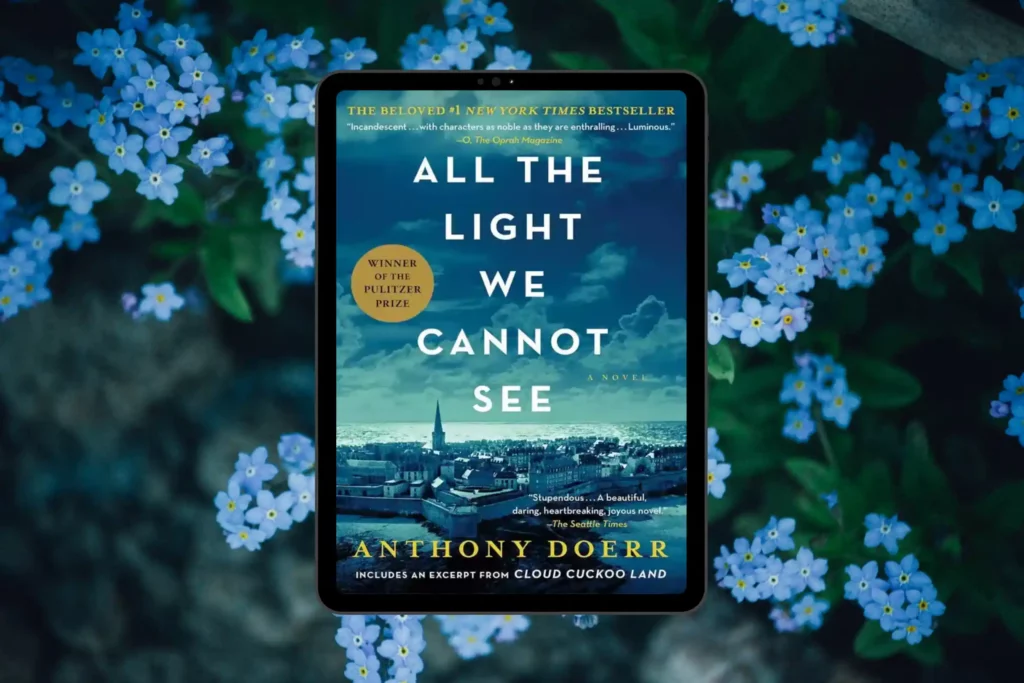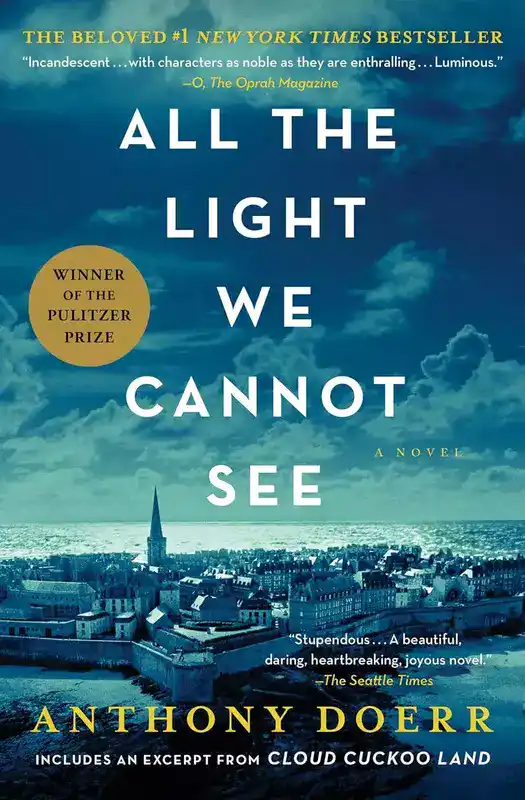This post may contain affiliate links. Read more here.

Note: the following guide contains spoilers, as well as references to critical plot points and the conclusion of All the Light We Cannot See by Anthony Doerr.
All the Light We Cannot See is a historical novel by Anthony Doerr, set during the final days of World War II. The story revolves around the experiences of two main characters, Marie-Laure LeBlanc and Werner Pfennig, as they navigate their challenging lives during the war.
All the Light We Cannot See by Anthony Doerr
The story revolves around the experiences of two main characters, Marie-Laure LeBlanc and Werner Pfennig, as they navigate their challenging lives during the war.
In this guide we will go through the complete summary, ending explanation and character analysis for All the Light We Cannot See. Enjoy! ✨
Summary | Ending Explained | Character Analysis | Quotes
All the Light We Cannot See Summary
Marie-Laure grows up in Paris, blind since the age of 6. Her father, Daniel LeBlanc, a skilled locksmith, supports her by creating a detailed model of their neighborhood and providing Braille books. Despite her blindness, Marie-Laure develops a rich imagination.
Werner, raised in a Protestant orphanage with his sister Jutta, displays exceptional intelligence. He builds a radio that captures broadcasts from different cities, offering hope for a better future. Wanting to escape a life in the mines, Werner joins a Reich-sponsored school, sacrificing his humanity for education.
Both Marie-Laure and Werner face significant challenges, with Marie-Laure coping with the loss of her mother and Werner dealing with poverty. However, their difficulties reveal their respective strengths—Werner’s intelligence and creativity and Marie-Laure’s imagination and love for nature.
The novel’s various sections lead to a pivotal moment where Werner and Marie-Laure cross paths. While not a typical love story, Werner falls for Marie-Laure and, in an act of courage, rescues her from a besieged Saint-Malo, defying his allegiance to the Reich and redeeming himself.
The story goes on after the war, showing what happens because of Werner’s kind act and revealing that Marie-Laure survives. Through Jutta’s son, Max, we get to see Werner’s bright curiosity persisting, now free from poverty and history’s shadows.
At the end of the book, we’releft with a strong feeling of how light triumphs over darkness, and the human spirit stays committed to holding onto its humanity, even in really tough times. The novel leaves a lasting impression, highlighting resilience and the inner strength we all have, especially when facing challenges.
All the Light We Cannot See Explained
So, what happens at the end of All the Light We Cannot See?
In the last part of the novel, Marie-Laure, who is now 86 years old, is with her grandson, Michel, at a park gazebo. Michel, almost 12 years old, takes her there.
Marie-Laure reflects on how much the world has changed, especially due to electronic communication, and how it shapes people’s lives. She envisions the souls of her lost loved ones being like invisible electronic messages, still around if only one could hear them. Marie-Laure understands that the world loses people because of the price of war.
The novel concludes with Marie-Laure, now an elderly woman, reminiscing while spending time with her grandson, Michel. They go to the park every week, and she thinks about the connections between people made possible by technology.
Marie-Laure recalls her lost family and friends, including Werner Pfennig, who made a significant impact on her life in just one day. Werner not only saved her life but also honored her wish for the Sea of Flames by returning it to the sea and letting her keep the key to retrieve it someday.
The story revisits the central question: What is the cost of war?
All the Light We Cannot See Character Analysis
Marie-Laure LeBlanc
Marie-Laure is a main character in the story, just 16 years old during the siege of Saint-Malo in August 1944. Blind since age 6, she is raised by her father, Daniel, a brilliant locksmith in Paris.
Despite her blindness, Daniel encourages Marie-Laure to face the world fearlessly, teaching her Braille and opening up an imaginative world through reading. Even after Daniel’s arrest during the war, he remains a significant influence. Other impactful figures include great-uncle Etienne, who fosters her love for learning, and Madame Manec, who teaches her to embrace life despite hardships.
Marie-Laure follows this advice, building a successful life with a career, a daughter, and a grandson, showing that one can lead a fulfilling life despite enduring past scars.
Werner Pfennig
Werner, the second protagonist, is 18 years old during the siege of Saint-Malo, where he rescues Marie-Laure. Fascinated by science from a young age, Werner’s desire to see and learn shapes his life. Intelligent, gentle, creative, and determined, he escapes the coal mines that claimed his father’s life by attending a Reich-sponsored school. Initially, Werner joins the school to avoid the mines but becomes ensnared in the ideals of the Reich.
Facing challenges due to his background, Werner’s idealism is shattered when his friend Frederick is brutally treated, breaking Werner’s loyalty to the Reich. Despite being broken by war experiences, he regains his humanity by rescuing Marie-Laure. His brief love for her allows him to die with dignity and freedom.
Frederick
Werner’s only friend, Frederick, is a dreamer and bunk-mate at Schulpforta. Despite his intelligence, obsession with birds, sensitivity, and conscience, Frederick struggles in the Reich school. Identified as one of the “weakest,” he endures beatings and bullying, refusing to harm a prisoner, which leads to severe injuries. Frederick’s kindness, conscience, and dignity teach Werner valuable lessons and serve as an example he struggles to live up to until the end of the novel. Frederick’s friendship and influence play a crucial role in Werner’s eventual redemption by saving Marie-Laure.
Daniel LeBlanc
Marie-Laure’s father, Daniel, is a brilliant and creative locksmith at the French National Museum of Natural History. Known for crafting clever puzzles, including the box holding the Sea of Flames, he creates model neighborhoods and puzzle boxes for Marie-Laure’s entertainment and education.
Devoted to raising his daughter, Daniel teaches her to navigate the world as a blind person and supports her education through interactions with experts in natural history. Despite being arrested and disappearing during the war, Daniel’s teachings and love leave a lasting impact on Marie-Laure, helping her overcome fears and aiding her in supporting her great-uncle, Etienne.
Madame Manec
Madame Manec, the mastermind of the Saint-Malo old ladies’ resistance club, passes away at the age of seventy-six from pneumonia. Strong-willed yet gentle, she imparts resilience and strength to Marie-Laure. Defying Etienne, she takes Marie-Laure to the beach and involves her in resistance activities. For sixty years, she cares for the LeBlanc family and supports Etienne’s fears for over two decades.
Madame Manec challenges Etienne to confront his fears and stand up for what is right, setting an example that forces him to overcome his fear and trauma after her death. Her legacy lives on through Marie-Laure’s commitment to continuing Madame’s work.
Jutta Pfennig Wette
Intelligent and creative like her older brother Werner, Jutta admires him and assists in gathering materials for his inventions, including a wireless radio. Together, they listen to Frenchman’s scientific broadcasts. However, exposure to radio broadcasts revealing German atrocities challenges Jutta’s loyalty to her government and Werner’s collaboration with the Reich.
Surviving the war, Jutta, burdened with guilt over Germany’s actions, seeks information about Werner. Visiting Saint-Malo in 1974, she discovers Marie-Laure and, to honor her brother, returns the model house. Marie-Laure, however, keeps Werner’s heroic acts a secret, sending a science program recording to Jutta for her son, Max.
Sergeant Major Reinhardt von Rumpel
Von Rumpel’s relentless quest for the Sea of Flames to cure his cancer illustrates the destructive power of greed and self-interest. Werner, driven by a desire to save Marie-Laure, ends von Rumpel’s life, releasing him from the clutches of the inhumane Reich. Von Rumpel’s death symbolizes the demise of the Reich, consumed by its own evil, akin to his body deteriorating from cancer, each carrying the seeds of its own destruction.
Etienne LeBlanc
Traumatized by World War I and the loss of his brother Henri, Etienne faces his fears to help his great-niece, Marie-Laure. After losing other adults in her life, Etienne becomes her only reliable support.
Recognizing the need to continue the resistance work of Madame Manec, he overcomes agoraphobia and other struggles to fulfill a parental role for Marie-Laure during the war. By confronting his fears, Etienne discovers a newfound courage, playing a crucial role at the age of 62 during the siege of Saint-Malo.
Frank Volkheimer
A physical giant, Frank Volkheimer, respects Werner for his intelligence and gentleness during their time at Schulpforta. Both assist Dr. Hauptmann in developing a transceiver for tracking radio broadcast locations. Volkheimer, thrown into war at 18, becomes in charge of their unit responsible for hunting partisan radiomen.
Despite his war-worn appearance, he shows kindness to Werner and shields him from the harsh realities of war, as he did in school. In 1974, Volkheimer, lonely and aged, delivers Werner’s belongings to his sister, displaying gentleness and kindness to little Max, reminiscent of Werner. Volkheimer’s character emphasizes the tremendous human costs of war.
How did you like the ending of the novel? Which character resonated the most with you?
Happy reading! ❤️
